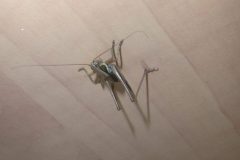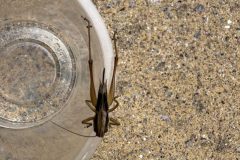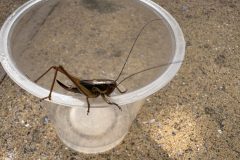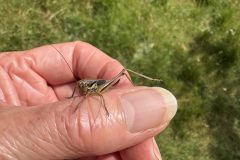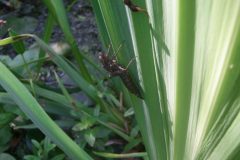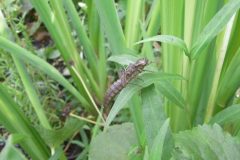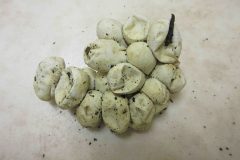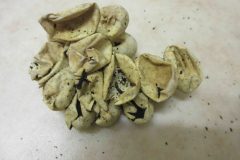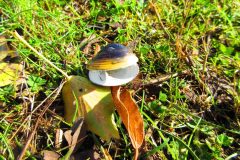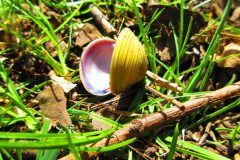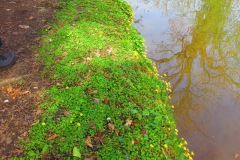16 June 2025
I was just on my way to hang some washing out this afternoon when I noticed this creature making its way up the side of my kitchen cupboard near the back door. I photographed it and then captured it and photographed it a few more times before giving it its freedom in our pint sized meadow – I was tempted to take it down to the churchyard to release it there but that would have been cheating. The fourth photo was of its reluctant release. It seemed to prefer my hand initially but at least I got a photo of it that showed its colours better. It was a Roesel’s Bush-Cricket, Roeseliana roeselii, and a first for our garden!
As it was hot I checked out the pond for Grass Snakes but found none. However I discovered that our Orchid, which I think is a Common Spotted Orchid, had in fact survived and sent up two flowering shoots. I also discovered three exuviae. One had broken in half but the other two were whole (the last two photos).
17 May 2025
An unusual sighting in our Finningley garden
Our eastern boundary comprises a retaining wall around 4ft high. Built out from this are brick built compost bins (formerly coal bunkers) with wooden tops and sloping wooden lids, which face south west and heat up well in the sun.
It was very warm on Saturday afternoon when at 3pm I was walking past the bins heading towards the shed. I suddenly became aware of a movement beside me that caught my attention. Looking to my left I was shocked to see a mature snake that I had disturbed that must have been basking on the warm wooden lids. I saw it slither down the end of the bins to the ground and then around some trays of pot plants. I spotted it emerge and slither along the narrow passage between the shed and the retaining wall, which is when I got a good view of it. It was around 2.5 feet long with the unmistakable yellow collar of a Grass Snake, Natrix helvetica. It made two attempts to scale the wall but the wall was too high. When it dropped down a second time towards the end of the shed I simply lost sight of it. I assume it had found a tiny gap between the end of the shed and the retaining wall of our bank and disappeared behind the shed since the bottom of the shed is fitted with mesh to prevent leaves from getting underneath. Although I looked at the far side of the shed I didn’t see it any more. However, at 6pm John was heading towards the shed and spotted it on the concrete path (which would still be warm) at the foot of the bins. He watched it slither round the corner towards the plants and came to fetch me, but of course it had disappeared by the time we got back moments later.
Louise pointed out that we may have another surprise in a few weeks time if the snake had been a female and had made use of the warm compost in which to lay her eggs. In fact I now believe we’d already provided the perfect incubator for last year’s brood. John discovered these empty eggs in one of our compost bins when he was turning the compost sometime in the autumn. I took the photos in November but think the empty egg cases had been around for some time.
Monday, 31st March 2025
On a beautiful spring morning at the end of March, John and I went for a walk along the Chesterfield Canal. Parking on Wiseton Road just outside Clayworth, we set off from Clayworth Gray’s Bridge (Bridge 69), walking towards Wiseton and almost immediately began to see empty bivalve shells.
These as can be seen, especially from the second photo, are clearly ridged. In the third photo, if you enlarge it and look carefully at the foreground, you can see how the predated shells were left scattered along the side of the towpath.
After some research I discovered they were freshwater Asian Clams, Corbicula fluminea, an invasive species that was discovered in the River Trent in 2007. We began to see them almost immediately we joined the canal at grid reference SK723887 and continued to see them for some distance until grid reference SK720892, over half way along the straight stretch of canal that meets with the lane into Wiseton.
In all the years we’ve been walking along the Chesterfield Canal, this is the first time we’ve seen them anywhere along the canal. I was curious as to what may have been fishing them out, eating them and discarding their shells? There had been some work carried out along the canal, involving cutting back vegetation along the edge of the canal and towpath, and John wondered if this might have had any bearing on what had happened.
Great Spotted Woodpecker’s early drumming
Great Spotted Woodpeckers are regular visitors to our Finningley garden peanut and fatball feeders. Last week, the male was recorded most days and this week it was the female I kept seeing. However, at 10.30am on Thursday 30th January we heard one of them drumming very loudly close by though we couldn’t actually see the bird. Although we do often hear Woodpeckers drumming close to home, I don’t think I’ve ever heard one drumming so early in the year before.
